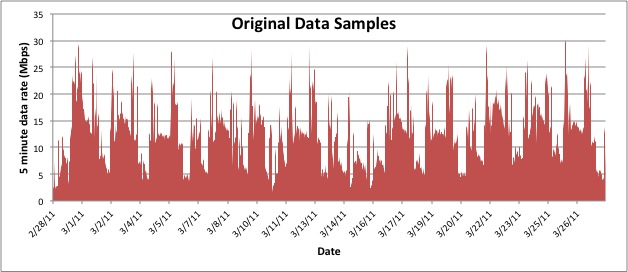What is 95th Percentile Billing?
Most service providers that offer ‘burstable’ or ‘flexible’ billing plans to their enterprise customers bill on the 95th percentile, also known as burstable billing. This allows customers to exceed their bandwidth commitment for brief time periods throughout the bill cycle (5% of the month) without incurring any data charges.
Data readings are taken every 5 minutes for each circuit. At the end of the bill cycle the readings are lined up, highest to lowest, and the highest 5% of readings are discarded. If the next highest reading is below the committed rate, then there are no additional data charges. However, if the next highest reading is above the committed rate, then ‘bursting’ data charges are applied to the customer bill.
For example, if there are 100 readings, the top 5 will be discarded, and the 94th reading will be the measure of the level of bandwidth used. Of course, there are many more than 100 5-minute samples in a bill cycle, so the top 5% of those readings are discarded. The images on the right illustrate how 5-minute samples over a bill cycle are sorted in order to calculate the 95th percentile used for billing.


# of Stamper Boxes in the "National Stamper Test Network"
%
Average Error % We Find in Usage Meters
Missing Revenue Identified in 2018
Is Your Burstable Billing Accurate?
If you’re like most providers we’ve worked with, that can be a tricky question to answer. Revenue assurance groups will typically have controls to compare usage captured to usage billed. But how can you be sure you’re collecting and measuring all of the usage a customer is actually generating?
When a customer downloads at an average speed of 500 Mbps over a 5 minute period, does your collection platform reflect that accurately? Does it show 480 Mbps – indicating lost revenue? Does it show 525 Mbps – indicating over billing?
The collection of 5 minute data samples on every circuit across your network can be a significant challenge. If you have 20,000 circuits collecting data samples every 5 minutes for a 30 day billing cycle, that is nearly 173 Million records. Are your polling and collection systems robust enough to handle that volume of data? Are you missing data points when the routers are too busy routing traffic to report back how much data they are routing? How is that impacting your billing and revenue?
If you’re struggling to answer any of those questions, ATS Usage Meter Accuracy platform can help. We create a controlled testing environment to generate known volumes of data on your network and compare those values with the recordings of your downstream systems. We also collect and analyze data from your other customer circuits to look for other potential issues including missed 5 minute data recordings.
What Do We Find?
Over the past several years, we have found usage meter accuracy ranging from 88% to 99.8% accuracy. While each analysis is unique, here are some of the more common issues we see…
- Under Reporting of Usage – Potential for lost revenue (i.e. Stamper downloads 100 MB but billing only shows 95 MB)
- Missing Poll Data – Particularly important for burstable billing
- Over Reporting of Usage – Potential for over-billing of customers
- Speed Limitations – Network congestion limiting the ability to download quickly and therefore reduce usage charges
- Poor Network Grooming – Non-optimal distribution of customers across networking equipment
- Speeds Offered vs. Speeds Delivered – Customers unable to reach the speeds they are paying for
